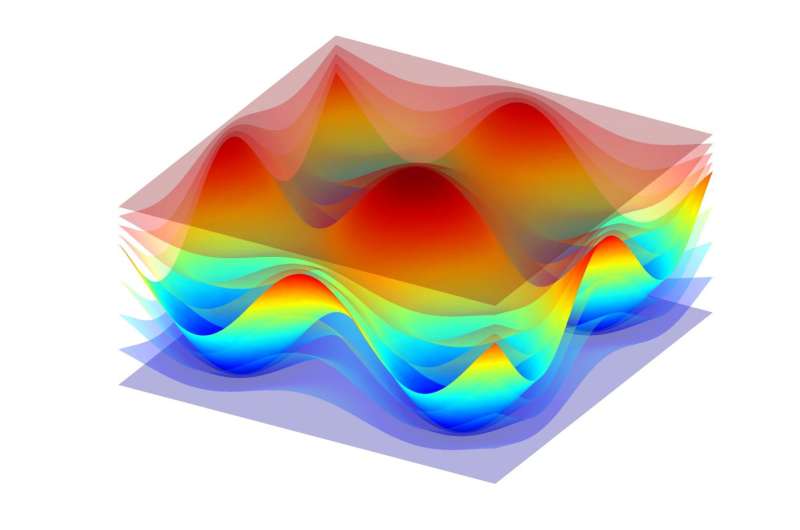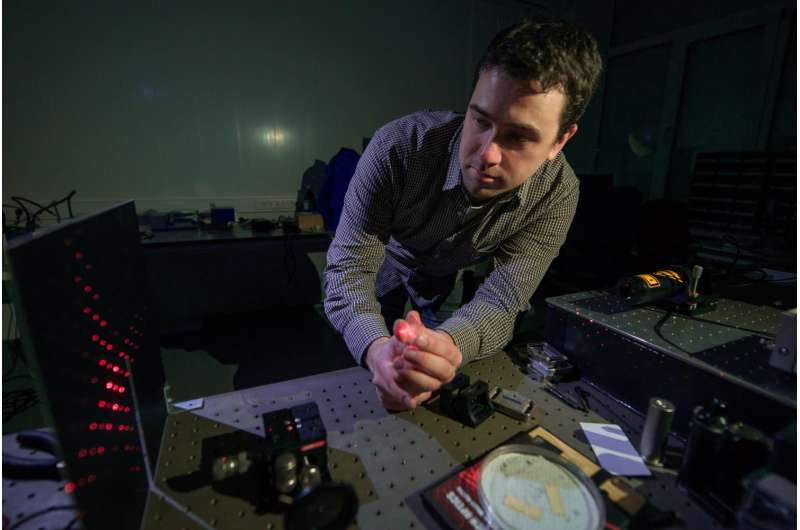Coordinate planes of a curvilinear coordinate system introduced in a region near a two-dimensional sinusoidal diffraction grating so that one of the planes coincides with the grating surface (an opaque surface). Credit: MIPT
Physicists from MIPT and University Jean Monnet (France) have developed a new simulation method for optical elements used in many modern instruments and devices. Their paper, presenting a description of the method which enables complex optical devices to be designed on gaming graphics cards, has been published in the Journal of Quantitative Spectroscopy and Radiative Transfer.
Alexey Shcherbakov, an employee of the Laboratory of Nanooptics and Plasmonics at MIPT's Center of Nanoscale Optoelectronics, and his colleague from University Jean Monnet Alexandre Tishchenko (1958–2016) proposed a new approach to calculating the optical parameters of complex diffraction gratings and diffractive elements. The possibilities of the newly developed method are significantly greater than those offered by other widely used methods for a variety of optical structures. The results of the study open new perspectives for the highly efficient optimization of modern optical and optoelectronic devices.
Diffraction gratings are optical elements that form the basis of many modern devices in spectroscopy, telecommunications and laser technologies. They are one- or two-dimensional periodic structures containing thousands of regular elements—e.g., a series of parallel strips of microscopic width. Diffraction gratings are capable of splitting white light into a spectrum, reflecting rays of different wavelengths in different directions – this is why they are used in virtually all spectrometers.
A good example of a diffraction grating is an ordinary compact disc. If it is illuminated with light of a fixed frequency a red laser pointer for example, instead of a single reflected beam, a set of reflected beams appears. These are referred to as diffraction orders. The directions in which these beams propagate are fixed and depend on the grating period (defined as the distance between adjacent elements), the angle of incidence, and the radiation frequency. Calculating the intensity of each diffraction order, i.e., the amount of the incident light power that is reflected in each direction, is far more difficult. Performing these types of calculations with high precision is extremely important from a practical viewpoint, since they are vital for the optimization of a wide variety of instruments and devices.
The capability of diffraction gratings to split light into a spectrum is used in spectrometers—devices that use the spectrum analysis to determine the composition of various substances including chemical solutions and interstellar gases. Diffraction simulation is essential for manufacturing lithography masks used in modern microelectronic fabrication, and for designing special polarizers in laser metal processing technology. In addition, periodic structures are used to increase the efficiency of solar concentrators and photovoltaic cells by increasing light absorption. Periodic structures also make it more difficult to forge documents and money—a pattern of fine metallic strips on paper that reflect light in a certain way can act as a forgery countermeasure.
A rigorous calculation of the diffraction order efficiency is only possible by solving Maxwell's equations – fundamental equations that describe the electromagnetic field and, in particular, electromagnetic wave propagation. They were formulated more than a hundred years ago, but a wide variety of solutions that these equations admit in different cases still motivates many scientists all over the world to continue to seek new solutions. And describing complex optical diffraction gratings using Maxwell's equations is only possible with the aid of numerical methods.
Alexey Shcherbakov demonstrates the diffraction pattern from a two-dimensional grating, credit: Credit: MIPT
This means that instead of a ready-to-use formula, a finite precision algorithm has to be implemented. To analyze and optimize complex diffraction gratings, researchers use modern computers and computer clusters. A whole field of science combining mathematical physics, numerical analysis, programming, and other areas is devoted to exploring how to write computer programs and perform these computations in the most efficient way. The development of this field is being spurred on by advances in fabrication technologies for diffraction structures. More precise devices pose increasingly high requirements to simulation methods at the design level.
In their publication, the researchers developed the Generalized Source Method (GSM), significantly reduced the consumption of computing resources compared to other methods. The idea is based on hypothetical sources of electromagnetic radiation which substitute structural inhomogeneity.
According to Alexey Shcherbakov, a senior researcher of the Laboratory of Nanooptics, this idea can, with certain limitations, be illustrated as follows: "Let's suppose we throw stones into the center of a circular pond. The waves generated by the stones will be circular and will spread out from the center of the pond to the water's edge. Now let us ask ourselves, what shape will the waves have if a boat is floating somewhere in the pond? It turns out that if we remove the boat and throw lots of small stones in the place where it was floating, these small stones can be chosen so that the total number of waves generated by them and the stone that we throw into the center will be the same as if the boat were still floating in the pond. This hypothetical substitution may seem to be complicating the task, but, in practice, this principle allows scientists to efficiently solve very complex problems of wave propagation."
The key idea of the new method based on the GSM was to use curvilinear coordinate transformations in the grating region. Within the method rationale, a rough grating surface is stretched to a plane, which makes it very simple to calculate the reflection and refraction of waves. Preserving the physical effects caused by the roughness requires simultaneously changing the properties of the environment near the surface in a certain way upon such stretching. Thus, instead of being reflected at the corrugated grating surface, waves appear to pass through an inhomogeneous space, which slows down their propagation differently in different locations. This technique significantly improves calculations obtains far more accurate results in the same calculation time.
In addition to the analytical development of the new approach with metric sources, the researchers also demonstrated the possibility of efficient parallelization of the method and performing simulations on graphic cards. This means that it is possible to use commercially produced components with which all gamers are familiar to simulate very complex diffraction gratings. The computing power of graphics chips is already greater than the power of processors, which is why graphics cards are used in many laboratories all over the world. In the published research, comparing simulations on graphics cards and ordinary processors showed that a graphics chip is able to do the task dozens of times faster.
More information: Alexey A. Shcherbakov et al, Generalized source method in curvilinear coordinates for 2D grating diffraction simulation, Journal of Quantitative Spectroscopy and Radiative Transfer (2017). DOI: 10.1016/j.jqsrt.2016.09.012
Provided by Moscow Institute of Physics and Technology






















